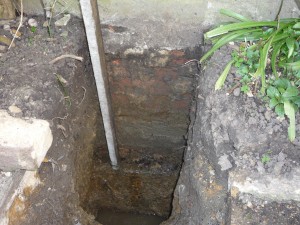Trial pit
A trial pit (also known as a test pit) is a type of intrusive ground investigation that is used as a means of determining the condition of the ground, typically before beginning construction works.
Trial pits are commonly used to investigate shallow ground conditions to develop an understanding of the profile of soils within the ground. They can be particularly useful where buried structures, variable conditions or contamination is suspected or needs further investigation.
They can be excavated by hand or using a backhoe excavator, generally to a depth of up to 3.5-4.5 m. If a trial pit is deeper than 1.2 m and is intended to be entered by people, it should be made secure against the possibility of structural collapse.
Trial pits (or trenches) can be more cost-effective than boreholes but they cannot reach the same depth. Trial pits can also excavated relatively quickly. However, they can cause significant surface disturbance and it can be difficult to properly fill excavations when the pit is no longer needed.
[edit] Related articles on Designing Buildings Wiki
Featured articles and news
Latest Build UK Building Safety Regime explainer published
Key elements in one short, now updated document.
UKGBC launch the UK Climate Resilience Roadmap
First guidance of its kind on direct climate impacts for the built environment and how it can adapt.
CLC Health, Safety and Wellbeing Strategy 2025
Launched by the Minister for Industry to look at fatalities on site, improving mental health and other issues.
One of the most impressive Victorian architects. Book review.
Common Assessment Standard now with building safety
New CAS update now includes mandatory building safety questions.
RTPI leader to become new CIOB Chief Executive Officer
Dr Victoria Hills MRTPI, FICE to take over after Caroline Gumble’s departure.
Social and affordable housing, a long term plan for delivery
The “Delivering a Decade of Renewal for Social and Affordable Housing” strategy sets out future path.
A change to adoptive architecture
Effects of global weather warming on architectural detailing, material choice and human interaction.
The proposed publicly owned and backed subsidiary of Homes England, to facilitate new homes.
How big is the problem and what can we do to mitigate the effects?
Overheating guidance and tools for building designers
A number of cool guides to help with the heat.
The UK's Modern Industrial Strategy: A 10 year plan
Previous consultation criticism, current key elements and general support with some persisting reservations.
Building Safety Regulator reforms
New roles, new staff and a new fast track service pave the way for a single construction regulator.
Architectural Technologist CPDs and Communications
CIAT CPD… and how you can do it!
Cooling centres and cool spaces
Managing extreme heat in cities by directing the public to places for heat stress relief and water sources.
Winter gardens: A brief history and warm variations
Extending the season with glass in different forms and terms.
Restoring Great Yarmouth's Winter Gardens
Transforming one of the least sustainable constructions imaginable.























